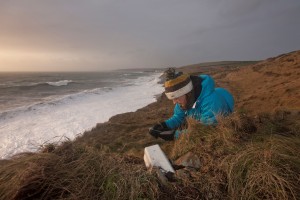4 February 2015
WASHINGTON, D.C. – The violent winter storms that rocked the United Kingdom in 2014 had the power to physically shake cliffs to a degree in excess of anything recorded previously, according to a new study.
A team at Plymouth University in the United Kingdom used seismometers, laser scanning and video cameras to evaluate the impact of the massive waves – up to eight meters (26 feet) high – that struck the cliffs in Porthleven, West Cornwall, during January and February of last year.
In a paper accepted for publication in Geophysical Research Letters, a journal of the American Geophysical Union, the team from the Coastal Processes Research Group at Plymouth University found that the level of shaking was of an order of magnitude greater than ever previously recorded.
They also recorded 1,350 cubic meters (47,675 cubic feet) of cliff face being eroded along a 300-meter (984-foot) stretch of coastline in just two weeks – a cliff retreat rate more than 100 times larger than the long-term average.
“Coastal cliff erosion from storm waves is observed worldwide but the processes are notoriously difficult to measure during extreme storm wave conditions when most erosion normally occurs, limiting our understanding of cliff processes,” said Claire Earlie, a PhD student at the School of Marine Science and Engineering at Plymouth University, and lead author of the new study.
“Over January-February 2014, during the most energetic Atlantic storm period since at least 1950, with deep water significant wave heights of six to eight meters (20 to 26 feet), cliff-top ground motions showed vertical ground displacements in excess of 50 to 100 microns; an order of magnitude larger than observations made previously anywhere in the world,” she said.
Using seismometers on loan from Scripps Institution of Oceanography in La Jolla, Calif., Earlie and the team embedded the instruments seven meters (23 feet) from the cliff edge. Within two weeks, they were just five meters (16 feet) from the edge, such had been the rate of erosion.

Claire Earlie, a PhD student at the School of Marine Science and Engineering at Plymouth University, uses a seismometer to measure cliff vibration caused by breaking waves on the shores of West Cornwall.
Credit: Lloyd Russell/Plymouth University
Terrestrial laser scanner surveys conducted from the beach also revealed a cliff face volume loss two orders of magnitude larger than the long-term erosion rate.
“The results imply that erosion of coastal cliffs exposed to extreme storm waves is highly episodic and that long-term rates of cliff erosion will depend on the frequency and severity of extreme storm wave impacts,” said Paul Russell, a professor in the School of Marine Science and Engineering at Plymouth University, who helped to supervise the project and is a co-author of the new paper.
“Our coastline acts as a natural barrier to the sea, but what we’ve seen right across South West England is unprecedented damage and change – from huge amounts of sand being stripped from beaches to rapid erosion of cliffs,” added Gerd Masselink, professor of coastal geomorphology in the School of Marine Science and Engineering at Plymouth University and a co-author of the new study.
“These figures will help to explain some of the invisible forces being brought to bear on our coastal structures, and highlight the risk of sudden cliff damage,” he added.
###
The American Geophysical Union is dedicated to advancing the Earth and space sciences for the benefit of humanity through its scholarly publications, conferences, and outreach programs. AGU is a not-for-profit, professional, scientific organization representing more than 60,000 members in 139 countries. Join the conversation onFacebook, Twitter, YouTube, and our other social media channels.
Notes for Journalists
Journalists and public information officers (PIOs) of educational and scientific institutions who have registered with AGU can download a PDF copy of this article by clicking on this link:
http://onlinelibrary.wiley.com/doi/10.1002/2014GL062534/abstract?campaign=wlytk-41855.5282060185
Or, you may order a copy of the final paper by emailing your request to Nanci Bompey at [email protected]. Please provide your name, the name of your publication, and your phone number.
Neither the paper nor this press release is under embargo.
“Coastal cliff ground motions and response to extreme storm waves”
Authors:
Claire S. Earlie: School of Marine Science and Engineering, Plymouth University, Plymouth, UK;
Adam, P. Young: Integrative Oceanography Division, Scripps Institution of Oceanography, University of California San Diego, La Jolla, California, USA;
Gerd Masselink and Paul E. Russell: School of Marine Science and Engineering, Plymouth University, Plymouth, UK.
Contact information for the authors:
Claire S. Earlie: +44 7590 025745, [email protected]
Nanci Bompey
+1 (202) 777-7524
[email protected]
University of Plymouth Contact:
Andrew Merrington
+44 (0)1752 588003
[email protected]